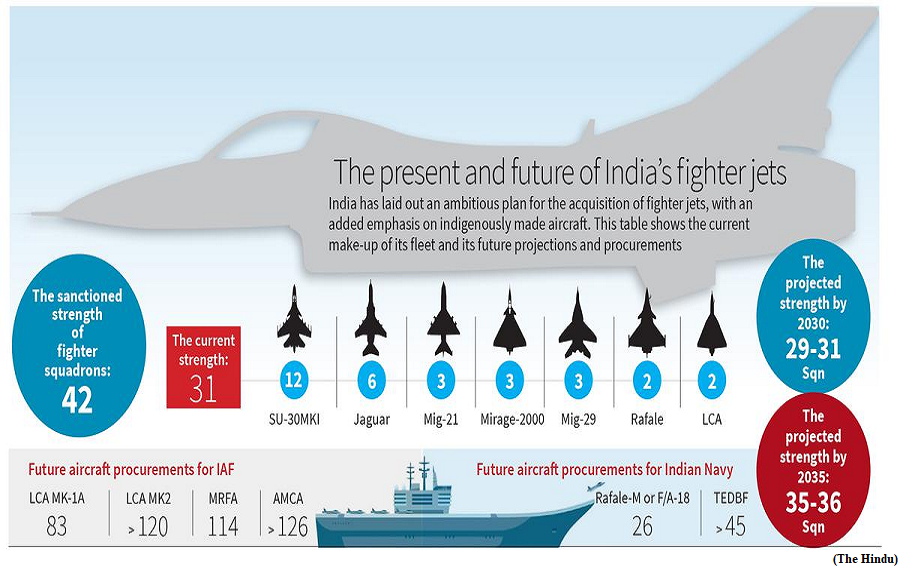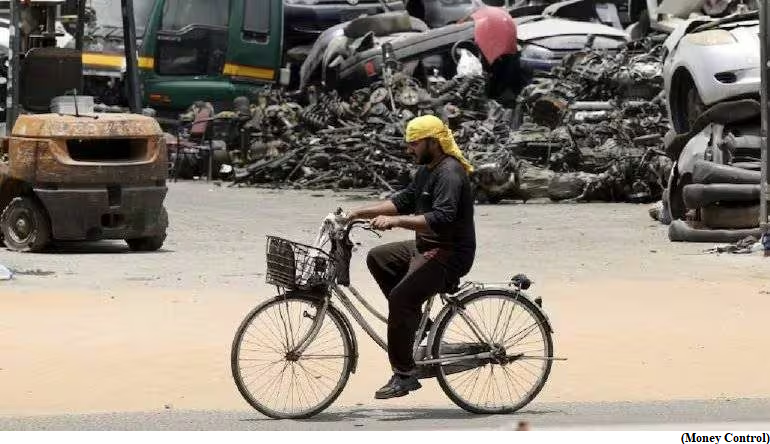India’s fighter jet conundrum (GS Paper 3, Defence)

Context:
- According to the Parliamentary standing committee on defence, against the sanctioned strength of 42 fighter squadrons, India is today at 31 squadrons which won’t go up in the next decade, but on the contrary can go further down by 2029.
- This sums up the conundrum faced by one of the world’s largest Air Forces in modernising its fleet which has been beset with unending delays in procurement.
Details:
- If what has been ordered is delivered, and the case for 114 Multi-Role Fighter Aircraft (MRFA) has progressed, then by 2030, IAF can be between 29 to 31 squadrons.
- The bulk of the heft to arrest the drawdown and ensure it doesn’t fall below 29 squadrons rests on the 83 Light Combat Aircraft (LCA)— MK1A, LCA-MK2 and MRFA. The decision on MRFA is essential to arrest this drawdown.
Phase-outs:
- Of the 31 squadrons at present, the three Mig-21 squadrons will be phased by 2025. Also, the Jaguars, Mirage-2000s and Mig-29s will begin going out by the end of the decade.
- For instance, by 2027-28 the first of the MIG-29s, inducted in the late 1980s, will start going out and by early 2040s, when most of these types will be phased out, some of the earlier batch of SU-30s will also start going out.
- The IAF has in total contracted 272 SU-30s. A deal to procure 12 additional SU-30MKIs to replace the ones lost in accidents as well 21 additional MIG-29s from Russia has been stuck.
New acquisition:
- India has an ambitious plan lined up for the acquisition of over 500 fighter jets, a bulk of them to be indigenously designed and manufactured, with a majority of them being for the IAF. However, these are at various stages of development. Their manufacturing and timely deliveries are critical.
- Apart from the new inductions planned, the IAF is confident that increasing the low availability rates of Su-30 and other fighters in service will offset some of the shortfall in the interim.
- However, that could be potentially impacted due to the Ukraine war, which has already affected payments to Russia for deals underway as well as delays and uncertainty in timely supply of spares for equipment in service.
Indigenous fighter ecosystem:
- The LCA which is the fulcrum of the indigenous jet development programme, originally intended as a Mig-21 replacement, has seen a series of delays and has now come back on track.
- The LCA achieved Initial Operation Clearance (IOC) in December 2013 and Final Operational Clearance (FOC) in February 2019. The IAF was supposed to get the 40 LCA from HAL much earlier but they are getting them now. Even now, it is two aircraft short of 40.
LCA-MK1A:
- Two decades since the first flight, in February 2020, the Defence Ministry signed a ₹48,000 crore deal with HAL for 83 LCA-MK1A. The project is on track to begin deliveries from February 2024.
- HAL will be delivering the first three aircraft in 2024 and 16 aircraft per year for the subsequent five years.
LCA-MK2:
- In addition to the LCA-MK1A, an even more capable and a larger LCA-MK2, which received sanction from the Cabinet Committee on Security (CCS) in September 2022 at a total cost of ₹9000 crore, is expected to be ready for production by 2027.
- Moreover, the fifth generation Advanced Medium Combat Aircraft (AMCA) is awaiting CCS sanction, the development of which would take 10 years after that. The project cost of AMCA is estimated to be around ₹15,000 crore.
- The LCA-MK2 will be similar to the Mirage-2000 in terms of capability and will be an important fillip as several jets currently in service begin going out.
- There is also a Twin Engine Deck Based Fighter (TEDBF) on the drawing board for the Navy’s aircraft carriers.
- They are looking at six squadrons of LCA-Mk2, seven squadrons of AMCA and upto 100 TEDBF.
MRFA:
- The other critical programme, the MRFA, is a reincarnation of the earlier Medium Multi-Role Combat Aircraft (MMRCA) contest for 126 jets.
- The MMRCA began when the Request for Information (RFI) was issued in 2007 and dragged on for a decade only to end up in knots and give way to the emergency procurement of 36 Rafale jets, earlier shortlisted under the MMRCA, under a €7.87 billion deal with France.
- The RFI for 114 MRFA was issued in April 2019 to global aircraft manufacturers but there has been no progress and the project is yet to receive the Acceptance of Necessity (AoN), the starting point of the procurement process.
- Given the huge budgetary outlays committed for the indigenous programmes, it has to be seen how the finances for the MRFA, which involves the manufacturer to set up plant in India, would be managed.
Oceans absorb 90 percent of human-induced planet warming, Study
(GS Paper 3, Environment)
Why in news?
- Human-induced climate change is skewing Earth’s energy balance and oceans are bearing the brunt of the heat accumulation, according to a new study.

Key Highlights:
- About 89 per cent of the warming in the last 50 years has been absorbed by the ocean and the rest by the land, cryosphere and atmosphere.
- About 381 zettajoules (ZJ) of heat accumulated on the planet from 1971-2020 due to anthropogenic emissions. One ZJ is equal to 10 to the power of 21 joules.
- This roughly equals a heating rate (Earth Energy Imbalance or EEI) of approximately 0.48 watts per square metre.
- About 89 per cent of the accumulated heat is stored in the ocean, six per cent on land, a per cent in the atmosphere and about four per cent available for melting the cryosphere.
Earth Energy Imbalance:
- EEI is the difference between incoming and outgoing solar radiation.
- It is an indicator of climate change that provides an estimate of how much, how fast, and where the Earth’s climate is warming, as well as how this will evolve in the future.
Impact of increment in heat:
- Researchers from several institutions updated the Earth’s heat inventory from a 2020 study to monitor climate change and provide community-based recommendations.
- The experts calculated that between 2006 and 2020, the EEI was 0.76 watts per square metre with a variable of ±0.2. The Earth will keep gaining energy, increasing planetary warming if the energy imbalance continues to exist or increases.
- Heat accumulated on land drives up ground surface temperatures. This may increase soil respiration, which triggers the decomposition of soil organic matter and plant litter by soil microbes, releasing carbon dioxide in the process.
- Higher soil respiration will likely decrease soil water, depending on climatic and meteorological conditions and factors.
- Heat storage within inland water bodies has increased to roughly 0.2 ZJ since 1960. For permafrost thawing, it was about 2 ZJ.
- The accumulation of heat in inland water increases lake water temperatures. This makes conditions ripe for algal blooms. Permafrost heat content could inject methane and carbon dioxide into the atmosphere, the researchers warned.
Ocean and troposphere:
- The upper ocean (0–300 and 0–700 metres depth) has taken up a major fraction of heat.
- The heat content from the surface to the bottom between 1960-2020 was roughly 0.14 watts per square metre. In the most recent period (2006-2020), the heat content was estimated to be approximately 0.68 watts per square metre.
- During 2006–2020, ocean warming rates for the 0–2,000 metres depth reached record rates of roughly 1.03 watts per square metre.
- The troposphere, the lowest layer of the atmosphere of Earth, measuring 8-14 kilometres in thickness, is also warming up due to increased heat accumulation.
- The upper troposphere in the tropics has warmed faster than the near-surface atmosphere since at least 2001.
Cryosphere:
- The cryosphere, the frozen water part of the Earth system gained roughly 14 ZJ of heat from 1971–2020.
- Half of the uptake triggered the melting of grounded ice, while the remaining half is linked to the melting of floating ice (ice shelves in Antarctica and Greenland, Arctic Sea ice).
- Antarctic Ice Sheet, including the floating and grounded ice, contributed about 33 per cent to the total cryosphere heat gain.
- Arctic sea ice stood second, having contributed 26 per cent. Melting glaciers and the Greenland ice sheet was responsible for 25 per cent and 17 per cent. The Antarctic Sea ice accounted for about 0.2 per cent.
90 percent of India is in danger range of heatwave impacts, says study
(GS Paper 3, Environment)
Why in news?
- Heatwaves across the globe are rising by the day, thus becoming more lethal and intense due to climate change.
- April 2022 stands as the hottest summer witnessed in 122 years, leading to at least 25 deaths. The cumulative heatwave-related mortality in India is over 24,000 deaths since 1992, as per PLOS Climate.

Heatwaves:
- As of now, nearly 90% of the country lies in the danger zone and almost all of Delhi is undergoing severe impact from the heatwave.
- In 2022, from the month of January to October, the country recorded extreme heat condition on 242 days out of 273, which include co-occurrence of heatwave as well as coldwaves.
- In India, heatwaves have known to occur particularly in the period of March to June. On an average, about two to three heatwaves take place every season.
- Climate change and global warming have increased the probability of heatwaves in the past three decades.
Impact:
- These heatwaves are bound to affect the country’s progress towards its Sustainable Development Goals (SDGs).
- India has committed to achieving 17 United Nations Sustainable Development Goals, including eliminating poverty, promoting good health and wellbeing, decent work and economic growth, quality education, among others.
Climate vulnerability of India:
- In order to analyse the climate vulnerability of the country, and how climate change may impact SDG progress, the scientists compared India’s heat index (HI) with its climate vulnerability index, (CVI), using various indicators to account for socioeconomic, livelihood, and other biophysical factors.
- PLOS Climate used a dataset that was publicly available on state level climate vulnerability indicators from the Indian Government’s National Data & Analytics Platform.
- The progress of the SDGs was measured amidst these rising heatwaves, the results of which showed that in the last 20 years, from 2001 to 2021, the progress of SGD with respect to the mortality due to these extreme weather conditions stated that while the effect of extreme weather events has intensified, the pace of SDG progress is slower.
- From 2019 to 2021, India’s global SGD rank is seen to be declining because the country failed to achieve the targets for 11 out of 17 SGD, out of which most were critically related to taking action towards climate change.
Assessment of Delhi Govt.
- The assessment by the Delhi government states that South and North-east Delhi are highly vulnerable areas, most susceptible to the impacts of climate change. However, the analysis by PLOS Climate states that the entire city is in the danger zone of HI levels.
- India ranks Delhi as the second best performer in terms of UN-SGD progress, but with the risk that its HI carries, this ranking is highly threatened.
Way Forward:
- So far, India has demonstrated impeccable leadership in creating heat action plans in the past 5 years through disaster management and providing relief resources.
- Along with these, many states have even begun to adopt the new guidelines for prevention and management of the ever rising heatwaves.




